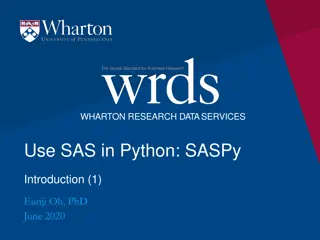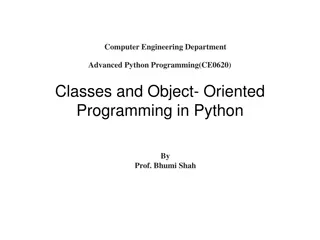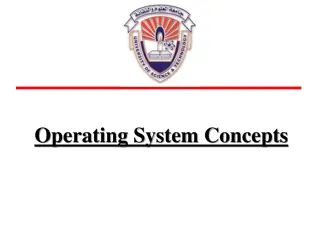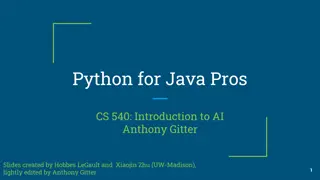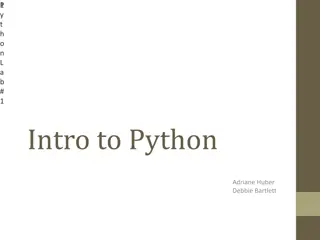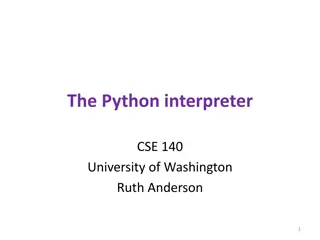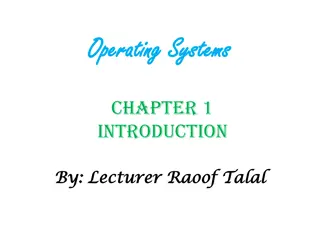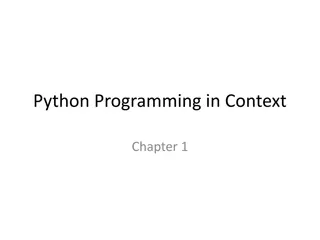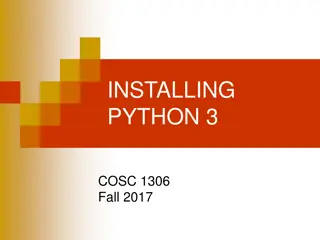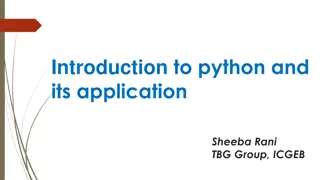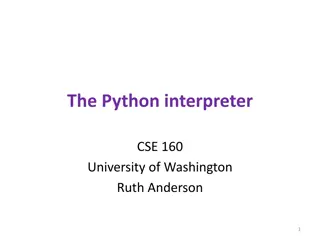Interacting with Operating System through Python's os module
The os module in Python allows you to interact with the operating system, providing functionalities like environment variable manipulation, file system navigation, and executing system commands. It enables access to environment variables, working with current directories, listing directory contents, walking through directory structures, and managing file paths using pathlib. With practical examples and methods like os.getcwd(), os.system(), os.walk(), and pathlib.Path, you can efficiently work with the OS within your Python scripts.
Download Presentation

Please find below an Image/Link to download the presentation.
The content on the website is provided AS IS for your information and personal use only. It may not be sold, licensed, or shared on other websites without obtaining consent from the author. Download presentation by click this link. If you encounter any issues during the download, it is possible that the publisher has removed the file from their server.
E N D
Presentation Transcript
OS The os module allows interaction with the Operating System, either generically or specific to a particular OS. https://docs.python.org/3/library/os.html Including: Environment variable manipulation. File system navigation.
Environment Variables These are variables at the OS level, for the whole system and specific users. For example, include the PATH to look for programs. os.environ A mapping object containing environment information. import os print(os.environ["PATH"]) print(os.environ["HOME"]) For more info on setting Env Variables, see: https://docs.python.org/3/library/os.html#os.environ
OS Functions os.getcwd() os.chdir('/temp/') os.listdir(path= . ) os.system('mkdir test') # Run the command mkdir in the system shell # Current working directory. # Change cwd. # List of everything in the present directory.
OS Walk A useful method for getting a whole directory structure and files is os.walk. Here we use this to delete files: for root, dirs, files in os.walk(deletePath, topdown=False): for name in dirs: os.rmdir(os.path.join(root, name)) for name in files: os.remove(os.path.join(root, name))
pathlib A library for dealing with file paths: https://docs.python.org/3/library/pathlib.html Path classes are either Pure : abstract paths not attached to a real filesystem (they talk of path flavours ); or Concrete (usually without Pure in the name): attached to a real filesystem. In most cases the distinction is not especially important as the main functions are found in both.
Constructing paths p = pathlib.Path('c:/Program Files') / 'Notepad++' Uses forward slash operators outside of strings to combine paths / . Though more platform independent is: a = os.path.join(pathlib.Path.cwd().anchor, 'Program Files', 'Notepad++') #See next slides for detail. p = pathlib.Path(a) >>> str(p) c:\Program Files\Notepad++ >>> repr(p) WindowsPath('C:/Program Files/Notepad++') For other ways of constructing paths, see: https://docs.python.org/3/library/pathlib.html#pure-paths
Path values p.name p.stem p.suffix p.as_posix() p.resolve() p.as_uri() p.parts p.drive p.root pathlib.Path.cwd() current working directory. pathlib.Path.home()User home directory p.anchor p.parents final path component. final path component without suffix. suffix. string representation with forward slashes (/): resolves symbolic links and .. path as a file URI: file://a/b/c.txt a tuple of path components. Windows drive from path. root of directory structure. drive + root. immutable sequence of parent directories: p = PureWindowsPath('c:/a/b/c.txt') p.parents[0] p.parents[1] p.parents[2] # PureWindowsPath('c:/a/b') # PureWindowsPath('c:/a') # PureWindowsPath('c:/')
Path properties p.is_absolute() p.exists() os.path.abspath(path) os.path.commonpath(paths) p.stat() Checks whether the path is not relative. Does a file or directory exist. Absolute version of a relative path. Longest common sub-path. Info about path (.st_size; .st_mtime) https://docs.python.org/3/library/pathlib.html#pathlib.Path.stat p.is_dir() p.is_file() p.read() True if directory. True if file. A variety of methods for reading files as an entire object, rather than parsing it. Listing subdirectories: import pathlib p = pathlib.Path('.') for x in p.iterdir(): if x.is_dir(): print(x)
Path manipulation p.rename(target) p.with_name(name) p.with_suffix(suffix) p.rmdir() p.touch(mode=0o666, exist_ok=True) "Touch" file; i.e. make empty file. p.mkdir(mode=0o666, parents=False, exist_ok=False) Make directory. Rename top file or directory to target. Returns new path with changed filename. Returns new path with the file extension changed. Remove directory; must be empty. If parents=True any missing parent directories will be created. exist_ok controls error raising. To set file permissions and ownership, see: https://docs.python.org/3/library/os.html#os.chmod https://docs.python.org/3/library/os.html#os.chown The numbers in 0o666, the mode above, are left-to-right the owner, group, and public permissions, which are fixed by base 8 (octal) numbers (as shown by "0o"). Each is a sum of the following numbers: 4 = read 2 = write 1 = execute So here all three are set to read and write permissions, but not execute. You'll see you can only derive a number from a unique set of combinations. This is the classic POSIX file permission system. The Windows one is more sophisticated, which means Python interacts with it poorly, largely only to set read permission.
Glob Glob is a library for pattern hunting in files and directories: https://docs.python.org/3/library/glob.html Also built into other libraries. For example, to build a list all the files in a pathlib.Path that have a specific file extension: a = list(path.glob('**/*.txt')) The ** pattern makes it recursively check the path directory and all subdirectories. With large directory structures this can take a while. Or: a = sorted(Path('.').glob('*.csv')) A sorted list of csv files in the current directory.
Some other I/O libraries tempfile Generate temporary files and directories: https://docs.python.org/3/library/tempfile.html shutil High-level file operations, like copying files and directory structures: https://docs.python.org/3/library/shutil.html


